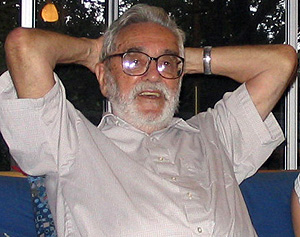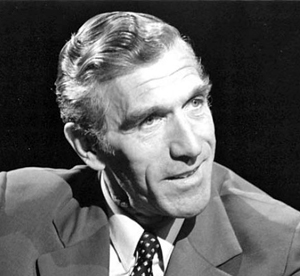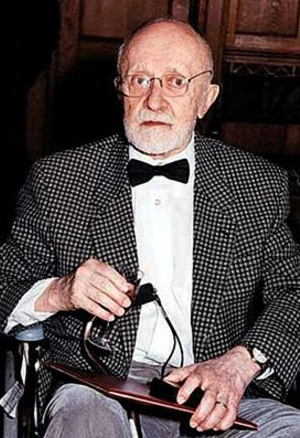Theory
“Wer nicht von dreitausend Jahren
Sich weiß Rechenschaft zu geben,
Bleibt im Dunkeln unerfahren,
Mag von Tag zu Tage leben.“
Goethe. (Neumann 2004: vi.)
“Who not for three thousand years
Knows to give account to himself,
Stays in darkness inexperienced,
May live from day to day.”
J. W. von Goethe (own translation)
Systems theory
Already in the 15th century in Belgium, people with mental health problems were given into the care of host families. The current system therapy builds on relation therapy. In both forms of therapy partners and family members are present. Clinically, however, until the sixties of the last century one worked mainly with individuals. The psychodynamic therapy included early childhood’s interaction patterns, with the parents and the client’s with the therapist. Like the behavioural therapy also the marital and family therapy knows of no single founder.

Austrian biologist, co-founder of the
general systems theory
emcsr.net 2012 © bcsss.org
The basis for a general systems theory came from the Viennese biologist Ludwig von Bertalanffy (1901 - 1972) already before the Second World War. It was his answer to a scientific causal reductionism, such as the medical stimulus-response model of behaviourism.
Systems theorists regard reality as too complex for an unambiguous connection between cause and effect. They see reality as a system, as a set of interrelated elements that mutually influence each other, and emphasize the relational network. Any change in a system’s element affects the whole system. Man is not only a system in itself, which for example processes information. Man is also an element, a component of other systems, such as a partnership, a family, an organization and a society. In this sense, a business, a family or an organization is more than the sum of the properties of its members. The whole is greater than the sum of its parts.
Systemic Therapy

Salvador Minuchiny, *1921, developed
structural family therapy.
Talgraf777 wikimedia.org
Systemic therapy does not focus on an individual but on a client system, such as a couple, a family or other durable group. Systemic work is based on systems theory or on system approaches. As therapists combined already existing methods with system theory and systemic methods, several forms and emphases came into being. One discerns three main streams.
Structure

Gregory Bateson, *1921, at the 48th
Spring Conference of the “American
Federation of Arts”. © aaa.si.edu
Missvain 2011 wikipedia.org
Salvador Minuchin was born 1923 in Argentina and worked in the sixties of the last century with ghetto youth in the U.S. He saw too little involvement in divided or loose-sand families and too much involvement in tangled-up or enmeshed families. Families and their balance benefited from the problem, maintained it and restored it after it was dissolved. The problematic youth served as scapegoats and lightning-rods. Coalitions between a parent and a child harmed the isolated parent and the child. Structural approach unravels twisted relationships, strengthens the relationship between parents, and restores their authority and the line between parents and children.

The Austrian-American communica-
tions expert, psychotherapist,
sociologist and philosopher also
influenced family therapy and
general psychotherapy.
© 2007 dpa/WDR[m]
Communication
Gregory Bateson (1904 – 1980), Jay Haley, (1923 – 2007) and the Austro-American Paul Watzlawick (1921 – 2007) worked in Palo Alto, San Francisco, California. They observed the patterns in which people communicate with each other verbally and nonverbally. Disorders in families became understandable from the communication processes in families. The Palo Alto group first thought that a contradictory communication from a mother to her child could lead to schizophrenia. This assumption was later abandoned. The change of pathogenic interaction and communication, which should solve the problems, retained the attention.
Context and Integration

Hungarian-American psychiatrist
and psychotherapist: systemic
constructivism, intergenerational
family therapy, contextual therapy.
diretoriopsicologos.com
The Hungarian I. Boszormeny-Nagy (1920 - 2007) made the importance of context and integration known in the U.S. He connected systems theory and psychodynamic perspectives. The attention to only the current functioning of families he found insufficient. He therefore worked intergenerational preferably with at least three generations. For grandparents already affected parents. This view made loyalties of parents to their parents visible, and their consequences for the children.
Pioneers of marital and family therapy pointed a way to group therapy. This again complemented individually targeted assistance with a focus on interaction patterns and group dynamics.
The Netherlands
In the sixties the individual problems slipped to the background and one experimented with marital and family therapy. The anti-psychiatric and socially critical climate of the seventies attested the system, family and society, sick and acquitted the individual. Already in the eighties one regarded the limitations of system approaches with growing scepticism. In the nineties client systems became more important, couple, core family and family, and theories and techniques retreated.
That the social environment greatly affects the creation and retention of a problem seems now widely accepted. Communication patterns no longer get the blame for mental health problems, and, the interaction between problem, individual and family receives attention. Marital and family therapy prove more effective by individual interventions. The attention for those who seek help helps better than a focus on family members who have no wish for help. The current approach is pragmatic and one chooses what one expects to help most to change unsuitable interactions in relationships.
At long last the therapeutic relationship remains in all forms of therapy more important than all the theory and technique. “Learn your theories as well as you can, and forget them as soon as you encounter the living soul”, already C. G. Jung ascertained.
The individual will hardly be able to follow and oversee the development of complex mixtures of therapeutic methods and techniques. The individual eclectic selection and integration of theories and practices by the therapist leads to therapeutic forms for certain problems and client groups; particular client groups will find one approach more attractive than others. In terms of the garbage can model of March and Olsen the solution is looking for its problem, and not vice versa.
Controversy
The phenomenon of set-up work quite often gets associated with the name Bert Hellinger. This page does not deal with controversial behaviours, practices and statements of persons who, understandably, can provoke violent protests in the media and possibly ensure publicity and sales. Here, only and exclusively controversies about theory, method and technique of constellation work are the issue, not controversies about people.
The history of systems theory and therapy makes understandable certain eclectic appearances of set-up methods and techniques. Yet features of setting-up still arouse doubts and protest. These cycle mainly around: the knowing field, brief therapy, projection and transfer, alleged ‘authoritarian’ or directive intervention, and alleged ‘patriarchal’ structure.
The Knowing Field
Within the still dominant materialistic-mechanistic science dogma the so called knowing field, which practitioners claim to work with, is neither to understand nor to explain. For this dogma it does not exist and remains fictional, irrational and transcendent. In this annoyance joins the sometimes numinous (Otto 1917) picture of the experience of this field that adjoins the religious-spiritual realm. Popular terms and esoteric references to, energies and vibrations, relativity, quantum theory and mechanics, will not change that the knowing field remains undetectable for the materialistic-mechanistic science dogma.
Alternative views relativize the dominant materialistic-mechanistic science dogma and make the knowing field imaginable: the hypothesis of morphic resonance (Sheldrake 2009), and the shamanic humanity (Van Kampenhout 2001, Lewis 1993).
DNA, genetic, epigenetic and social factors alone cannot explain recurring behaviour over generations (Dobbs 2013). However, non-spatial morphic resonance makes it understandable. Authorized by the client representatives and facilitators may enter the field of the client and discern its tendencies. Brains and body thereby appear more like a radio receiver for the non-spatial information of the morphic field, than internal data media. Creative and economic intervention then seeks to pursue changes in the field of the client.
In the shamanic worldview man has several souls, not only one. One or more of these souls can get lost in the transcendence, for example by shock or trauma. The shaman enters into a trance for his client, and looks for the lost souls, brings them back into his client and realigns them. According to the shamanic humanity the therapist and representatives can get in touch with these souls, to assist the client in solving his problem.
Morphic hypothesis and shamanic paradigm phenomena can make it easier to understand some phenomena that occur in constellation work, but they will not fully explain them.
The Short Therapy
For a therapist, who has worked for many years devotedly on a client’s problem, it may seem unbelievable, when this problem suddenly should be dissolved in just one session at another therapist. However, it is known that prior to the decisive moment of the solution many conversations, interventions and more preceded the solution. For the therapist, who is aware of his and his client’s limitations, and the sometimes mysterious ways of the soul, it remains a gift, almost like from above, when a client at some point experiences the change he was looking already for a long time.
If a client comes to a set-up facilitator it usually stays at one session. Within the tradition of the brief therapy such is not so surprising. The short therapy, attempts to quickly penetrate to the actual core and current question for help of the client, and demands of the client to compress what he is looking for into one sentence. Out from this basis therapist and client continue to work targeted for the solution, in the knowledge that any solution is only one step towards the more complete human being.
From the viewpoint of depth psychology, which accompanies and promotes the natural unfolding processes of the soul, the short therapy may appear like a first aid operation. Yet precisely the depth psychologist knows that every soul has its own time and moments, which are not in his hand and sometimes not even in the hand of the client. The therapist will therefore get out the tool out of his treasury that best fits the request of his client.
Projection and Transfer
Projection infers that one transfers own affects onto the environment. In a systemic constellation, the therapist, the client and his representatives get carried away by these mostly unconscious affects and their processes, critics suppose.
According to the Jungian experience man constantly unconsciously projects what is in him out onto his environment. Thereby it is not necessary that the environment, the other individual or collective who serve as a projection screen for this transfer, actually is or has what gets projected onto her, him or them (Cohen, Hamaker-Zondag 2008, Rump 2002). Strong positive and negative affects, such as love and anger, can make this rather painfully obvious. A transfer from the client onto the therapist calls within the therapist again for a possible counter-transference. A skilled and experienced therapist will recognize this timely within himself, and reject this invitation to unconsciously project or transfer something back onto his client, and will fertilize his sensation for the good his client (Freud, Jung, Derksen 1993, Solomon and Siegel 1997).
Comparable to one-sided or mutual enamourment and aversion, with which someone can flawlessly as a sleepwalker hit upon the right opposite, to live out her or his positive or negative affects, clients may choose for constellations representatives with whom they ‘have something with’. In the set-up such projections then get often surprisingly quickly unmasked and become conscious, and the wrong image about the other and oneself can be adjusted. Of course, within the setting of a constellation, usually such is not worked out cognitively and verbally at first, but in the mostly non-verbal syntax and vocabulary typical for constellation work.
As in an individual session, also in a group session the facilitator continually and carefully guards himself to remain independent inside. If he allows himself to get seduced by what is outside of him and comes up in him -, such as demand and threat, isolation, pain and sadness, indifference and indignation, silence and bursts, prestige, reputation and success, compassion and the desire to helpfully intervene -, he loses his inner independence and intervention capability. If he remains inwardly free of projection and transfer, he can intervene efficiently and effectively within the possible.
The ancient Chinese wisdom of Wu Wei expresses the necessary attitude aptly with the paradox: ‘doing by not doing’ (Fischer 2007).
Directive and ‘Authoritarian’ Intervention
Critics accuse therapists and facilitators of constellations, to sometimes treat clients directive or even ‘authoritarian’, to exercise power and to force something on clients.
While this probably happens more often than any therapist may wish, informed literature defines power positive and negative. However, power itself is neutral and part of every human relationship (Pfeffer 1994). Accepted power authorizes leadership and becomes authority. Unauthorized display of power demands unconditional obedience and is called authoritarian and dictatorship. However, authorized invitation or assignment is called authoritative.
The sociologist Max Weber distinguished charismatic, traditional and rational-legal authority. The philosopher Jürgen Habermas proposed communicative rationality as opposed to rationality of power, dialogue as opposed to the arguments of money and weaponry. For the psychoanalyst Jean Baker Miller the need to dominate others stems not from a sense of power, but rather from a sense of powerlessness (Eisler 1997: 196, 230).
A client who contracts a therapy authorizes the power of his therapist as a basis for the therapeutic relationship. The cognitive-behavioural approach, for example, works by definition directive, has the character of a teaching situation and places emphasis on learning. It refers more to a change of the person than for a better adaptation (Derksen 1993: 179, 243).
Regardless of method and technique of any form of therapy, authority and advance trust that the client invests in the therapist, along with his expert knowledge, experience and judgment of his and the client’s capacity and situation, and, not to forget, both their nature, character and human maturity, will determine the margin of what and how much the therapist dares to ask of the client at a given moment
As for power I refer to the work of two therapists that seems too little known among some who work with people:
A. Guggenbühl-Craig, Power in the helping professions, Spring Publications, 1971;
E. Neumann, Depth psychology and a new ethic, Putnam’s sons, 1969.
‘Patriarchal’ Structure
Critics accuse therapists and facilitators of constellations, to sometimes confirm and impose patriarchal structures on clients.
Already Marx and Engels saw in the oppression of women by men a suppression of the ‘first class’, the ‘world historical defeat of the female sex’ (Eisler 1997: 196). This implies that once it was different. For many Western people patriarchal structures are so unconscious and a matter of course, that already the theming thereof appears to them foreign and superfluous.
Archaeologists found that the early Stone Age in Europe knew no patriarchy (Gimbutas). Anthropologists showed that non-Western societies still are organized around women (Haviland 1991, Kloos 1991). The lineage gets matrilineal defined through the mother. Women form with their children the core of the family and the role of men as husbands and fathers remains peripheral. The marriage settlement takes place in the family of the woman. In the West, however, a wife and child usually receive the name of husband and father, who is also considered the head and kernel of the family, and traditionally marriage establishment takes place in the family of the man. Although changes in the West can be seen, a change from a millennia old androcratic culture towards a realistic alternative of equality between women and men still will take generations.
It is therefore no surprise that in therapies established androcratic structures and symptoms become visible and sometimes also get confirmed, because a change of this often unconscious consensus in a system still would ask too much presently. In set-ups for clients from a non-Western cultural background matrilineal structures and dynamics usually become immediately visible and active. The informed and trained therapist will thus consciously work towards a balance for the client, by not only respecting matrifocality, matrilinearity and matrilocality, but also by consciously and creatively employ it. Androcratic solutions work there just as little as gynocratic solutions for the Westerner, unless in the system concerned there exists already a developed gylanic consciousness and consensus about it (Eisler 132).
Prospect
The more the limits and drawbacks, of a carried away capitalism and of the dominant scientific materialistic-mechanistic paradigm as prevailing dogma, become apparent, the more likely alternative perspectives and approaches, open experiment and science will get again opportunities (Sheldrake 2012). Microscope, telescope, oscilloscope and more are essential to understand ourselves and the world, but they neither can see nor show everything concerning man. There are still aspects of human existence, which cannot be examined by lifeless equipment, waiting for necessary attention and recognition.
Human sciences, such as anthropology, sociology, psychology and depth psychology, developed methods and techniques for reliable research results and conclusion. Man is thereby not only researcher and researched, subject and object, but also agent and research tool. An anthropologist records his inner response to the population that he investigates by fieldwork as consciously as his external participative observation, qualitative analysis and inter-subjective conclusion (Kloos). A therapist observes consciously his inner response to the client and adjusts by it, in the knowledge about projection, transference and countertransference, his conversation and intervention.
A solidly underpinned human-scientific foundation and a comprehensive systematic theory of the phenomenon of constellation work are still missing. Only recently doctors and therapists began an interdisciplinary and international cooperation to scientifically research the interdependence between physical symptoms and constellation work. I am looking forward to the results and further developments...